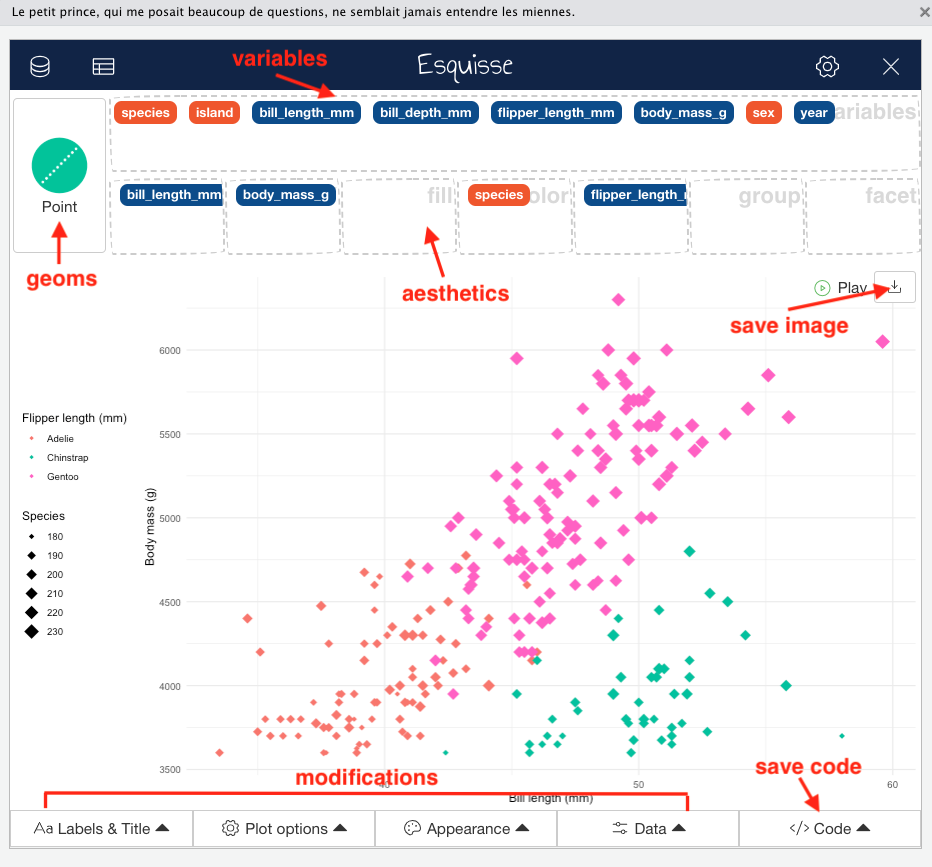Exploring the Wide World of ggplot2 Extensions
Learning Objectives
- Understand where to find packages that extend
ggplot2 - Make animated plots with
gganimate - Interactively create plots with
esquisse - Convert
ggplot2plots to interactiveplotlyplots - Label data with
ggrepel
Packages
Extensions to ggplot2
There are many kinds of extensions to ggplot2, but many of them can be put into one of two “bins”
- Packages that add new layers
- Packages that wrap multiple layers for convenience
Packages that extend ggplot2
Some packages add new layers or themes that can be combined with standard ggplot2 functions.

Packages that wrap ggplot2
Other packages provide convenience “all-in-one” functions that combine multiple layers for you.

Finding Extensions
Browse the
ggplot2extensions galleryCheck out the Awesome
ggplot2listGoogle search with “ggplot2” keyword
Package Demos
gganimate

gganimate

plotly
plotlyR package is interface to a JavaScript library for making interactive data visualizationsOnly important to know that because if you search for
plotlyhelp, sometimes you’ll get JavaScript code examples.plotlykind of uses the grammar of graphics, but building a plot from scratch is trickyggplotly()transformsggplotobjects into interactiveplotlyplots. 90% of the time it gets you 90% of the way there
Basic interactive plot with plotly
Customize tooltip
You can customize the info displayed in the tooltip with ggplotly(). Give it additional aesthetic text to include something only as a tooltip.
p2 <-
ggplot(penguins, aes(x = bill_length_mm, y = bill_depth_mm, color = species)) +
#Ignore unknown aesthetics warning
geom_point(aes(text = sex)) +
labs(x = "Bill length (mm)", y = "Bill depth (mm)", color = "Penguin Species") +
theme_bw()
ggplotly(p2, tooltip = c("text", "bill_depth_mm", "bill_length_mm"))Warning
Output not shown because currently plotly does not play nicely with Quarto revealjs slides (how this slide deck was made)
Animate plots with plotly
You can use ggplotly() to make interactive animated plots by using the frame aesthetic
Warning
Output not shown because currently plotly does not play nicely with Quarto revealjs slides (how this slide deck was made)
esquisse
ggrepel
The ggrepel package is helpful for directly labeling plots, especially when labels would otherwise overlap.


Getting Help
gganimate: Getting started guide, referencegplotly(): https://plotly.com/ggplot2/esquisse: Getting started guide, referenceggrepel: Gallery of examples, list of available aesthetics you can map data to.Our drop-in hours
Anything we missed?
Got a ggplot2 question we didn’t cover in this workshop series? Let’s figure it out together!

